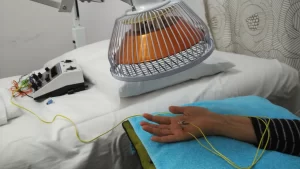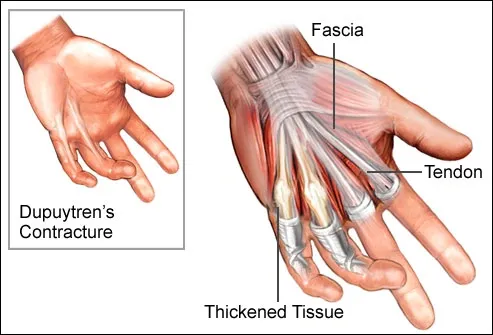Dupuytren’s contracture (Dupuytren’s disease) is a condition that affects the hands and fingers. It causes one or more fingers to bend into the palm of the hand. It can affect one or both hands, and sometimes affect the thumb.
Dupuytren’s contracture occurs when the connective tissue in the palm thickens. Often the tissue thickens in one small area first and a “nodule” forms (a small, hard lump about 0.5-1cm) under the skin of the palm. The nodule sometimes feels tender to begin with, but this usually passes. More nodules may then develop.
The nodules are non-cancerous (benign) and the condition isn’t life-threatening for those who develop it, although it can be a nuisance to live with.
Over time, the nodules can extend and form cords of tissue. These cords can shorten (contract) and, if the cords run along a finger or thumb, they can pull it, so it becomes bent towards the palm. These contractures are often mild and painless, but they can get steadily worse over time.
Why it happens
The exact cause of Dupuytren’s contracture is unknown, but it’s thought to be related to your genes, as it often runs in families.
Who’s affected
Dupuytren’s contracture is fairly common. It can affect both sexes, but affects men more than women. The condition usually occurs during later life, although cases have been reported in children. Most cases occur in men over 50 and women over 60.
Preventing Dupuytren’s contracture
As the exact cause of Dupuytren’s contracture is unknown, it may not be possible to prevent the condition.
Treating Dupuytren’s contracture with acupuncture
Most Dupuytren’s contracture will benefit from acupuncture and tui na treatment. we will assess your condition and put together a tailored treatment programme.
The aim of our treatment is to break up the nodules and restore function. The approach will depend on the severity of the condition. Almost everyone will benefit from our programme, which might include:
- infrared heat therapy
- needling with electro-stimulation
- deep heat therapy
- Tui Na massage to ease stiffness and break up the scar tissues
- advice on fingers stretching exercises to increase the range of joint movement


In more severe cases, surgery can help to restore hand function. The two most common surgical techniques are:
- open fasciotomy – where the shortened connective tissue is cut to relieve tension
- fasciectomy – where the shortened connective tissue is removed
Surgery for Dupuytren’s contracture can’t always fully straighten the affected finger or thumb, and the contracture can recur after surgery. If a contracture does recur, further surgery may be possible.
Having surgery to remove the first nodule that appears won’t stop the condition from progressing, as this won’t stop the condition occurring elsewhere in the palm. It’s usually best to avoid surgery until a contracture develops that interferes with use of the hand.

